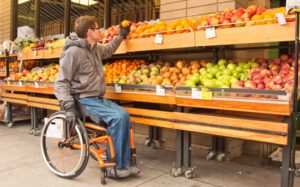Elevation Wheelchair
The Elevation wheelchair allows users to change the configuration “on-the-fly” to enable greater function, independence, comfort, and promote activities of daily living.
Its seat height and backrest recline angle adjustment capabilities allow the user to self-adjust their sitting posture to best suit their current activity. The Elevation is capable of up to 10 inches of on-the-fly seat height/dump adjustment and 30° of back angle/recline adjustment.
Buy one today, visit PDG Mobility!
Evolving the Elevation Wheelchair
The REDLab has recently evolved the Elevation concept to include more functionality. A new “kneeling” feature was incorporated into a new frame design. This allows users to bring the front of the chair closer to the floor to do things many wheelchair users can’t typically do (e.g. play with children or get back into the chair from a fall).
Designing wheelchairs to facilitate transfers continues to be of interest to our group. This wheelchair prototype is currently being evaluated with end users to examine its functionality and performance.
Stability, Function, and Dynamic Seating
In collaboration with researchers at SFU, we are looking at stability and performance issues with wheelchair designs that offer adjustable seating position.
Dynamic Wheeled Mobility (DWM)

The concept of Dynamic Wheeled Mobility (DWM) involves incorporating features into a wheelchair’s design, or using add-on components, to allow users to change the configuration of their wheelchairs to suit different environments or activities. Steve Mitchell of the Cleveland Veterans Administration Medical Center and Jaimie Borisoff introduced the DWM framework to the mobility industry, most recently at the 2015 International Seating Symposium.
Dynamic Wheeled Mobility: The Next Chapter in the Ultralight Evolution
Jaimie F. Borisoff, PhD British Columbia Institute of Technology Steven J. Mitchell, OTR/L, ATP of the Cleveland VAMC SCI/D Service
DWM Add-On Accessories
We are developing accessories aimed at enabling participation in the community and improving health. These include new pushrim designs, power-assist wheels, and wheel attachments that reduce rolling resistance.
Our new technology will:
- Expand the terrains that are possible to traverse/access in a Manual Wheelchair (MWC).
- Allow users to go further, reduce fatigue, aches and pains in all wheeling conditions, including indoor stops/starts and over typical barriers like damaged sidewalks.
- Remain modular, light and portable for easy transport and quick restoration to base MWC function.
A base MWC is configured for typical activities, but when needed, components are attached to enable greater function. These include passive “front-ends” that improve rolling resistance, powered front-ends, power-assist wheels, and rear-drive systems. A MWC can easily return to base form when the add-on is not needed anymore, remaining a light, portable device useful in most situations in the home, community and when travelling.
Contact Us
Jaimie Borisoff
Rehabilitation Engineering Design
Director, MAKE+
BCIT Centre for Applied Research & Innovation
4355 Mathissi Place
Burnaby, BC V5G 4S8
